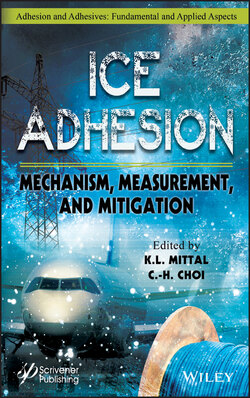Читать книгу Ice Adhesion - Группа авторов - Страница 9
Оглавление
Preface
A glance at the literature will evince that currently there is brisk activity regarding understanding and mitigating ice adhesion. This emanates from the overwhelming importance of ice adhesion and its ramifications. Here a few eclectic examples will suffice to underscore the detrimental and disastrous effects of snow/ice accumulation: skidding on ice and hurting oneself; impairment of visibility due to ice layer on windshields and difficulty in opening car doors; damage caused by freezing rain storms; flight delays (a big nuisance) and danger to the plane and passengers due to ice accumulation on airplane wings; significant decrease in lift and rapid rise in drag due to ice accretion over in-flight aircraft surfaces; and ice accumulation on ship hulls causing navigational difficulties and extra expenditure to carry additional ice load. During winter in cold countries, accumulation of ice on high-tension power lines can have a devastating result— power interruption, which is a public nuisance with serious collateral side effects. Over the years, there have been many unfortunate events that can be attributed to ice adhesion.
This book containing 20 chapters is divided into three parts— Part 1: Fundamentals of Ice Formation and Characterization; Part 2: Ice Adhesion and Its Measurement; and Part 3: Methods to Mitigate Ice Adhesion. The topics covered include: factors influencing the formation, adhesion and friction of ice; ice nucleation on solid surfaces; physics of ice nucleation and growth on a surface; condensation frosting; defrosting properties of structured surfaces; relationship between surface free energy and ice adhesion to surfaces; metrology of ice adhesion; test methods for quantifying ice adhesion strength to surfaces; interlaboratory studies of ice adhesion strength; mechanisms of surface icing and deicing technologies; icephobicities of superhydrophobic surfaces; anti-icing using microstructured surfaces; icephobic surfaces: features and challenges; bio-inspired anti-icing surface materials; durability of anti-icing coatings; durability of icephobic coatings; bio-inspired icephobic coatings; protection from ice accretion on aircraft; and numerical modeling and its application to inflight icing.
The information on the topic of ice adhesion is scattered in many diverse publication media and no book, to our knowledge, is available which addresses the various aspects of ice adhesion in an easily accessible and unified manner. We hope this book fills the lacuna in the literature and this provides the vindication for bringing out this book.
This book should be of much interest to glaciologists, meteorologists, surface scientists, materials scientists, nanotechnologists, coatings technologists, and those concerned with the detrimental effects of ice adhesion in the aviation, ship, railway, power transmission, wind turbine, and refrigeration industries. Also physicists interested in understanding the fundamentals of ice formation should find this book very useful. The book should be of interest to both veteran researchers as well as to those who wish to make their maiden voyage in the immensely important field of ice adhesion.
The strategies presently used to combat ice accumulation problems involve chemical, mechanical or electrical approaches. These are expensive and labor intensive, and the use of chemicals raises serious environmental concerns. So the availability of truly icephobic surfaces or coatings will be a big boon in preventing the devastating effects of ice accumulation.
Currently there is tremendous interest in harnessing nanotechnology in rendering surfaces icephobic or in devising icephobic surface materials and coatings, and all signals indicate that such interest will continue unabated in the future. It should be emphasized that currently the key issue regarding icephobic materials or coatings is their durability. So much effort is being spent in developing surface materials or coatings which can be effective over a long period. With the tremendous activity in this arena, there is strong hope that in the not too distant future, durable surface materials or coatings will come to fruition.
The chapters in this book are written by eminent researchers hailing from many parts of the globe. So this book is veritably international in coverage and spirit. It represents the cumulative wisdom of many researchers and provides a commentary on the state of the art in the extremely important arena of ice adhesion. Furthermore, we are quite sanguine that this book containing bountiful information will serve as a fountainhead for new research and development ideas. It should be recorded here that all chapters were rigorously reviewed and all were suitably revised (some twice or thrice). So the material presented in this book is of archival value and meets the highest standard of publication. Also the book is profusely illustrated and copiously referenced.
Now comes the pleasant task of thanking those who were instrumental in making this book possible. Obviously, first and foremost, our sincere and heartfelt thanks go to the authors for their keen interest, their sustained enthusiasm, their unwavering cooperation, and sharing their valuable research experience in the form of written accounts without which this book could not be materialized. Also we would like to take this opportunity to extend our thanks to Martin Scrivener (publisher) for his keen interest in and steadfast support for this book.
Kash Mittal P.O. Box 1280 Hopewell Jct., NY 12533, USA E-mail: UshaRMittal@gmail.com
Chang-Hwan Choi Stevens Institute of Technology Hoboken, NJ, USA E-mail: cchoi@stevens.edu August 2020
